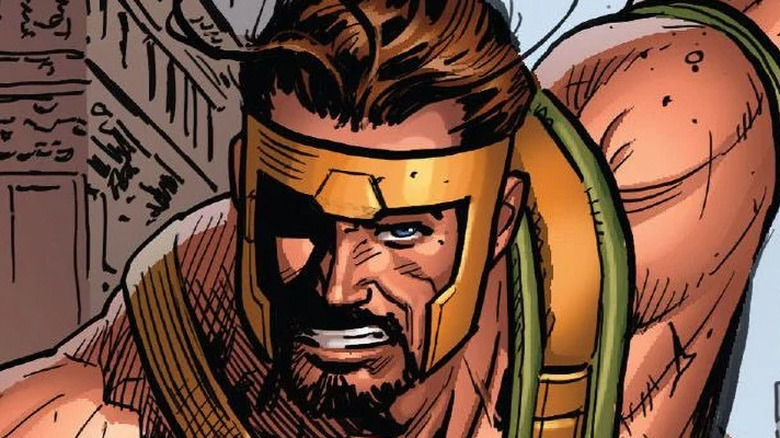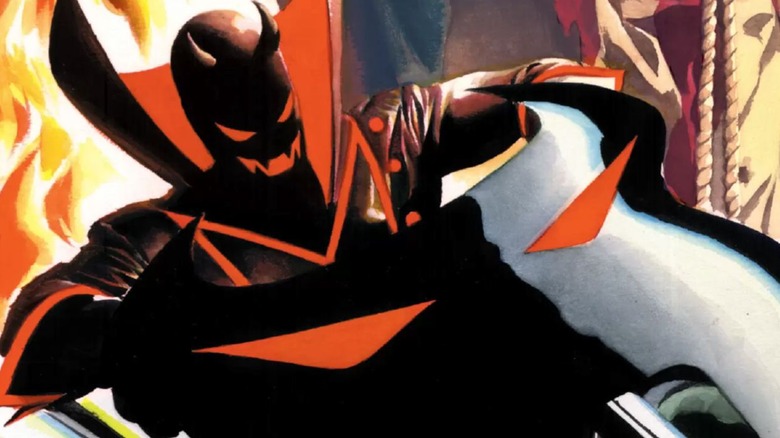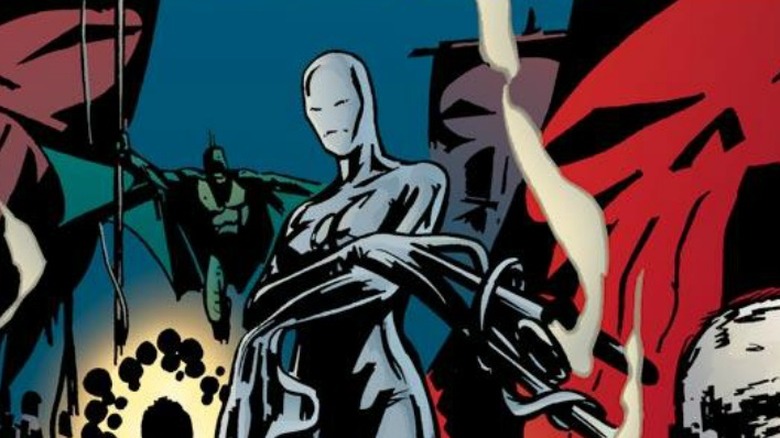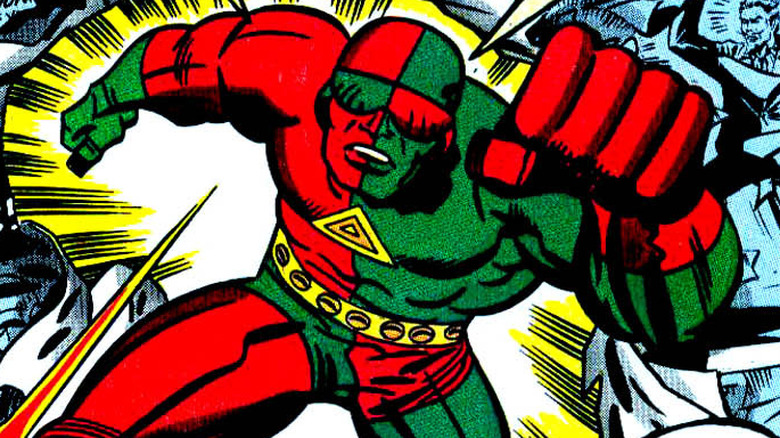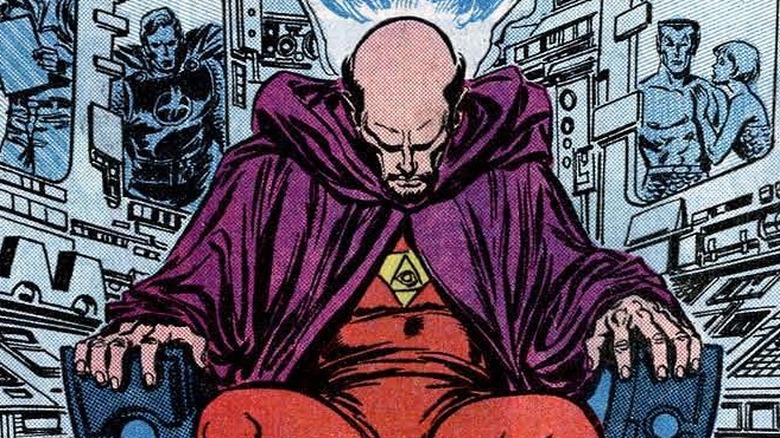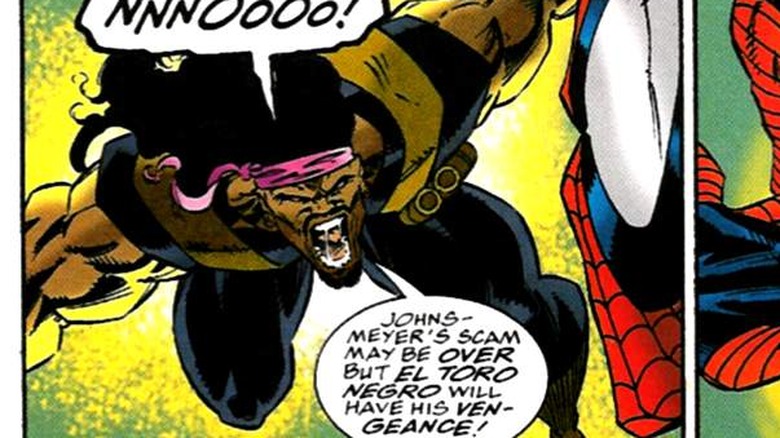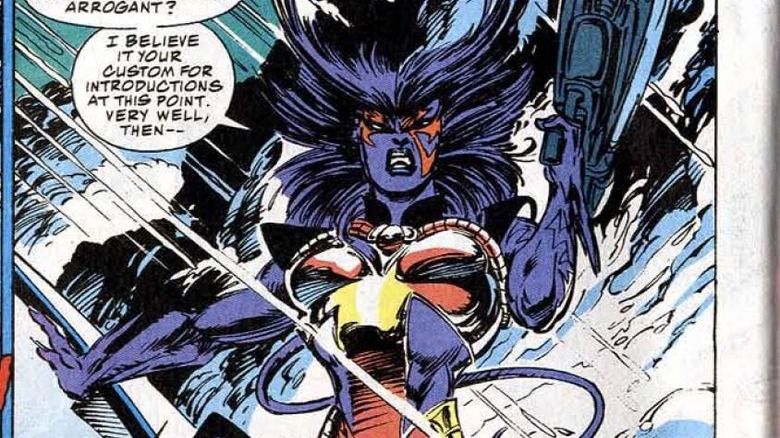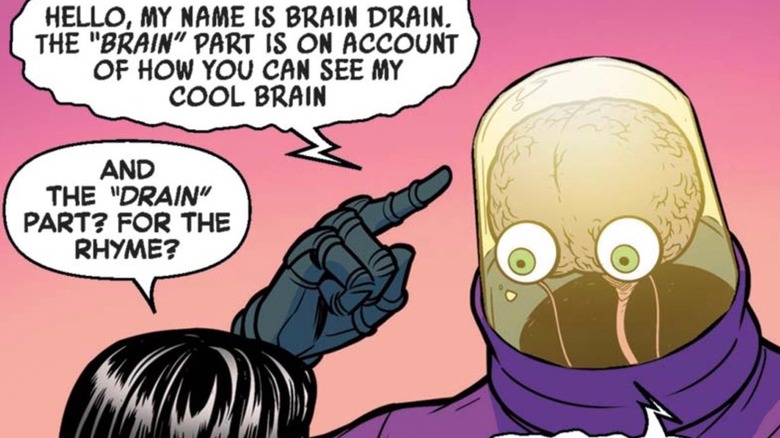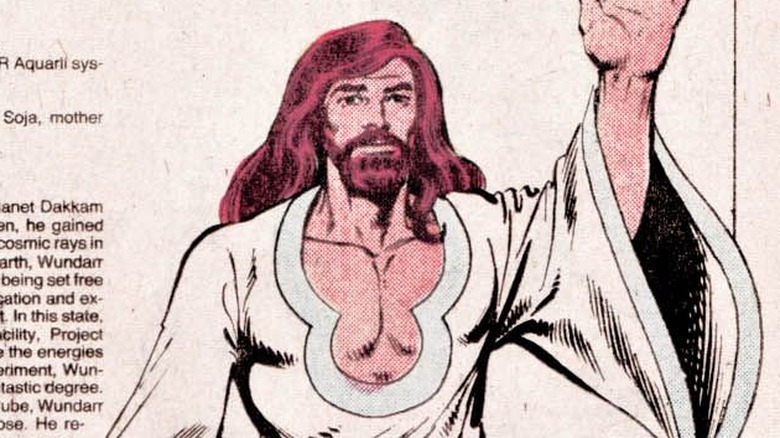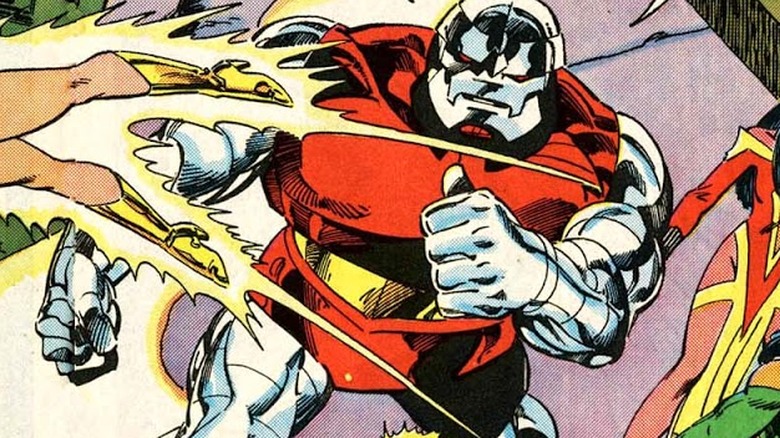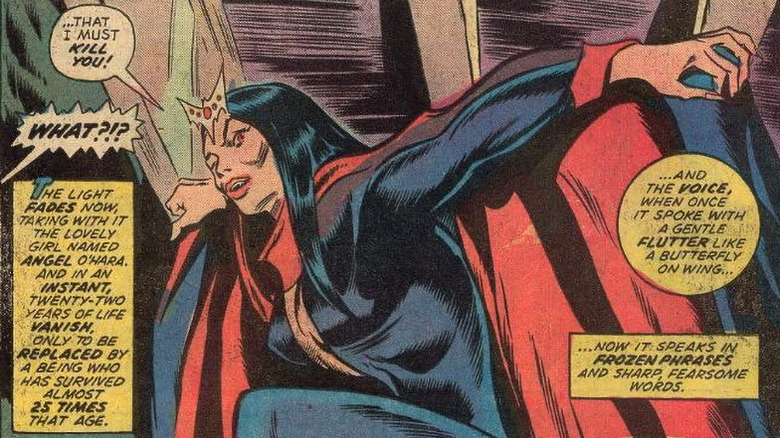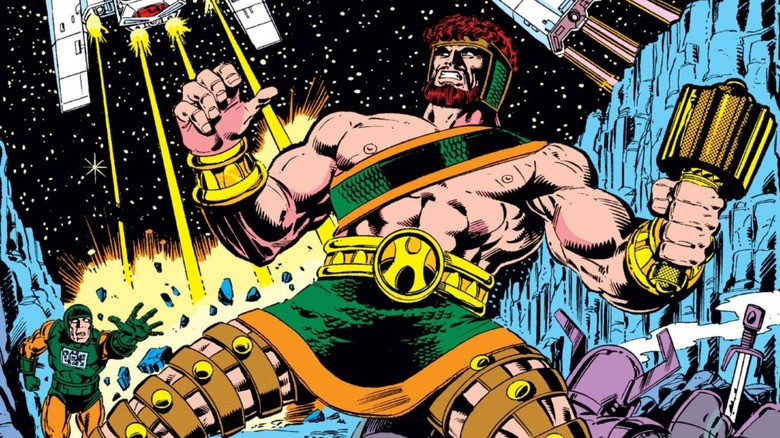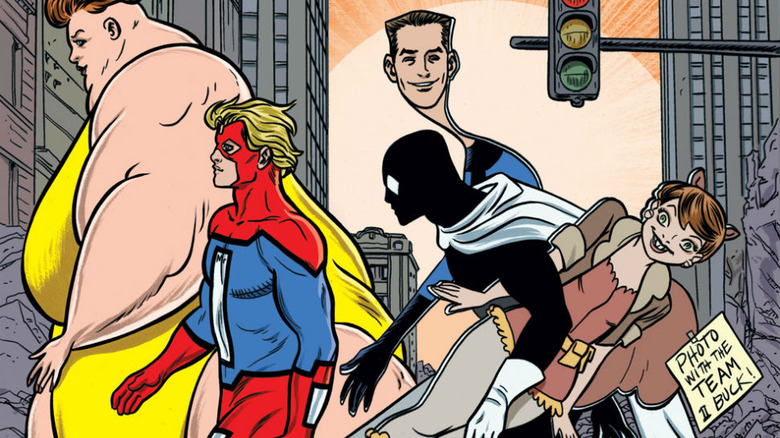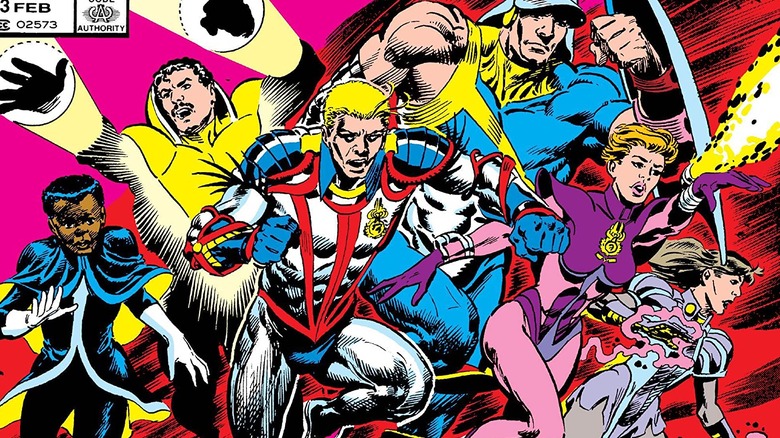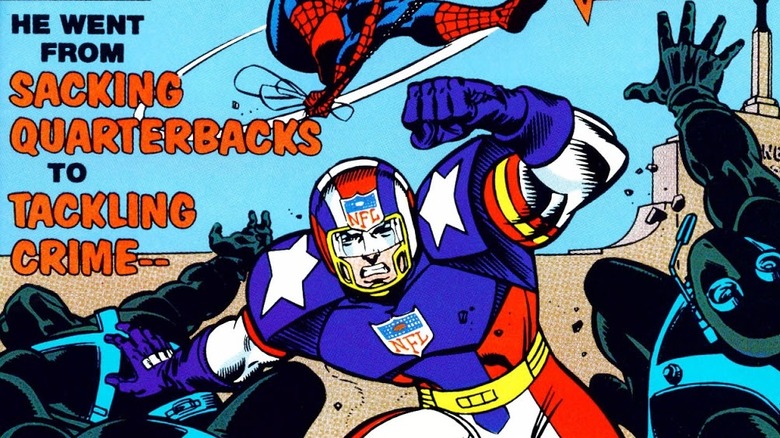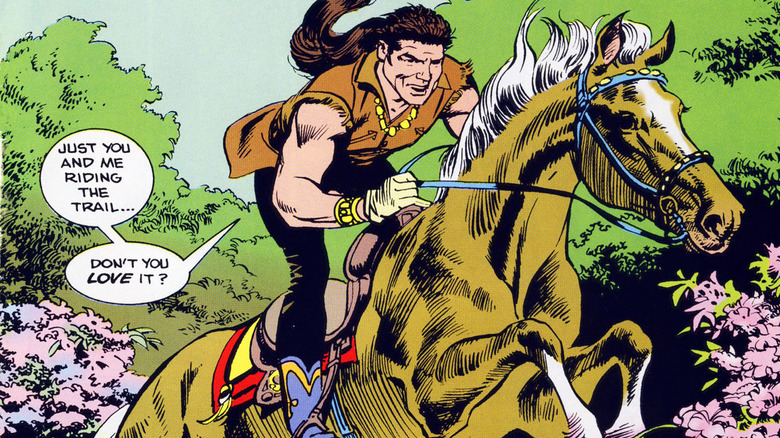Forgotten Marvel Comics Superheroes That Deserve To Be In The MCU
If we consider the official beginning of the modern Marvel Comics universe to be the publication of "Fantastic Four" #1 in 1961, that means the House of Ideas has been churning out new stories and characters several times a month for over 60 years. For every Spider-Man or Wolverine that becomes a household name, however, dozens of heroes and villains are dreamed up and promptly tossed into the bin of pop cultural obscurity.
Like films, songs, or any other unit of creative energy, some superheroes simply don't make much of an impact. Some appear before their time. Others don't resonate in their original context, but could thrive if repackaged for a different medium. A few are so baffling to modern eyes that they demand attention in a way their creators never intended. What unites the obscure heroes we're taking a look at today are their eye-catching natures, killer designs, and intriguing powers. They could make one heck of a splash on the silver screen, if only they were able to get there. These are the forgotten Marvel Comics superheroes who deserve to make their mark on the MCU, no matter how bizarre, complex, or just plain goofy they are.
Daredevil (Earth X)
1999's "Earth X," by Jim Krueger and John Paul Leon, offers a grim vision of the Marvel universe's future. It also introduces a uniquely enigmatic Daredevil, who provides some much-needed comic relief. The 2020 series "Marvels X," by Krueger and Well-Bee, fleshes out his real name and origin story. But let's face it: When someone says "Marvel's Daredevil," they're talking about Matt Murdock, or potentially Elektra Natchios. They're almost never talking about immortal jester David Jarrett, the Daredevil of "Earth X."
Jarrett is a performer in the spirit of Evel Knievel who repeatedly stages his own gruesome death to the nihilistic delight of circus crowds. Decapitation and severe burns are no big deal for him — this Daredevil's superpowers are regeneration and resurrection. This is pretty ironic, because, as he tells everyone constantly, his greatest wish is to experience the sweet relief of death. He's kind of like Deadpool, except even more unpleasant. Just imagine this Dormammu-faced goofball begging Doctor Doom to rip him in half like a phonebook in a massive crossover movie like "Secret Wars III." It's potentially classic, no?
Iron Maiden
"Earth X" contains a handful of faces who could add some bizarre, lightly-fatalistic flavoring to the MCU. Consider the chronically depressed drifter with cartoonish eyes and sensitive red panels all over his skin. Obviously, he calls himself Spiders Man.
But the most promising candidate for an "Earth X"/MCU crossover would have to be the vibranium-powered metamorph known as Iron Maiden. Once a scientist employed by Reed Richards, she gained a handy collection of liquid metal-based abilities when a terrifying laboratory accident coincidentally occurred at the same moment every normal person on Earth inexplicably developed superpowers.
If you want to get a handle on Iron Maiden, picture the T-1000 from "Terminator 2: Judgement Day," then add the power of flight and a gentle soul. Finally, throw in the kind of wide-eyed dumbfoundedness you might expect from an everyday working stiff who basically slipped on a banana peel and stood up with a set of preternatural talents roughly equal to Superman's. And hey, wouldn't a Marvel hero with "Iron" in her name be a shoe-in for a project like "Armor Wars"? Just sayin'.
3-D Man
Basically an updated version of Joe Simon and Jack Kirby's Captain 3-D from the 1950s, 3-D Man came to fruition in 1977's "Marvel Premiere" #35. He wields the strength and speed of a normal person, multiplied by three. While it might've been neat for him to live up to his name and leap off the page at readers who observe his exploits behind disposable 3D glasses, 3D comics have never quite managed to become commercially viable. Audiences have been tossing down extra dollars to watch blockbuster films in 3D at theaters for decades, however. Attempt to turn 3-D Man into a comic book star would be a pretty dumb move on Marvel's part, at this point ... But bringing him into the MCU? That's a different story.
Imagine a new Avenger who can only be seen clearly through the classic red-and-blue plastic lenses. Or, perhaps he could appear on a Disney+ program that imports the 3D movie theater experience into your very own living room. If 3-D Man offers the MCU a chance to do something creative with its respective mediums, who cares if he was ever a stupid idea? Everyone would be having too much fun watching him pop off the screen to notice.
Doctor Druid
Anthony Druid (aka Doctor Druid and Doctor Droom) made his debut in 1961's "Amazing Adventures" #1, predating the first appearance of the Fantastic Four by a few months. Sadly, Steve Ditko and Stan Lee premiered a superior iteration of the same idea two years later in Doctor Strange, sinking Druid's breakout potential for good.
Why should Kevin Feige bother devoting valuable time and resources towards bringing Druid to the big and/or small screen, you ask? Because he has a cool-sounding name, first off. But most importantly, while his overall presentation certainly calls Stephen Strange to mind, it also channels another quintessential sorcerer of 1960s horror-fantasy: the Master from 1966's "Manos: The Hands of Fate."
The MCU definitely can't use the real, original Master from the schlock classic, but they could absolute reinvigorate Doctor Druid by turning to the cult flick for inspiration. A weirder wizard could also bring unique storytelling elements into the MCU mix, and offer Benedict Cumberbatch a rival to bounce off of — something every "Sherlock" fan knows he excels at. Plus, we would finally get the "Spider-Man"/"Manos" crossover we've always dreamed of! What — just us?
El Toro Negro
Among the many prominent Spider-Man storylines of the '90s, 1993's "Maximum Carnage" and 1994's "The Clone Saga" easily overshadow 1995's "The Great Game." Perhaps the concept was ahead of its time: Here in the 2020s, where superheroes have been thoroughly commodified and billionaires shoot themselves into orbit, a story about bored wealthy people placing bets on costumed adventurers fighting to the death seems a natural fit.
Most of the titular Great Game's participants, including Polestar, Joystick, and Tremolo, scan a little too one-dimensional and derivative to warrant a live-action iteration. While you could accuse El Toro Negro's creators of borrowing more than a little inspiration from Bane, Batman's least-favorite muscle-bound demagogue, we think the MCU could use a little Santa Priscan energy. El Toro Negro is tough, mean, arrogant, and much more interested in getting paid than destroying the universe. He's certainly a villain as long as he's in the employ of Justin Hammer, but a screen version could just as easily fight on the angels' side if, let's say, Pepper Potts ever needs some folks roughed up.
Deathcry
Okay, so we recognize that Deathcry routinely appears on lists of all-time worst Avengers. Though we might argue that the comics content industrial complex has been unfair to her, just because she isn't that bad doesn't mean she's on Iron Man or Black Widow's level, y'know? But Deathcry — an ill-tempered bird person and assassin who might be related to the Shi'ar royal family — is a mishmash of absurd '90s superhero comics clichés, and the MCU is sorely lacking in that department. We think she deserves a spot in the MCU on the strength of her gravity-defying mullet alone.
Think about it — almost every major MCU character first appeared in 1960s comics. Why do the baby boomers always get everything? What about millennials and gen Xers? Shouldn't they get something from their childhood every once in a while too? Even with Deadpool tentatively on the way, Deathcry's ends-justify-the-means approach to superhero-ing, inability to dress with a mind toward practicality, WWF-style face paint, and goofily hardcore name make her uniquely suited to represent a decade missing from the MCU.
Brain Drain
Brain Drain is a literal brain and pair of eyeballs floating in a glass bowl attached to a robot body. It is deeply regrettable that he began his career in 19775's "Invaders" #2 as a WWII supervillain, but he's long since realized the error of his ways and undergone multiple personality overhauls. In his most recent appearances in Ryan North, Erica Henderson, and Derek Charm's award-winning series, "The Unbeatable Squirrel Girl," Brain Drain is firmly on the side of Squirrel Girl's anti-evil efforts ... despite his penchant for indulging in nihilistic, fatalistic philosophy.
As we are all but specks in the galaxy, our lives mere seconds relative to the infinite totality of time, someone in the MCU needs to ask an important question: What is the meaning of wearing garish costumes and battling back existential threats from the cosmos? Otherwise, the MCU is in danger of becoming a mere spectacle of colorful characters punching and blasting each other for no purpose other than our own infantile amusement.
Okay, yeah, we'll admit that's actually what we all come to the MCU for. But Brain Drain's existential musings make him a one-of-a-kind character with enormous potential. "Squirrel Girl" proves how absolutely hilarious he can be: Just imagine him teaching an "applied existentialism" class to Peter Parker and his school chums.
Wundarr the Aquarian
This suave stack of pancakes began his fictional life in 1973's "Fear" #17 as a Superman parody (or plagiaristic rip-off, if you asked DC's lawyers at the time). He comes from the diabolical minds of Steve Gerber and Val Mayerik, the men who brought us Howard the Duck. A few years later, exposure to the Cosmic Cube grants Wundarr a degree of spiritual enlightenment. He grows out his beard, embraces New Age trends, and achieves his final destiny as a disco-y Jesus impersonator. He even has his own cult for a while.
Let's take a moment to remember that, in the world of the MCU, half the population literally disappeared, then reappeared five years later. When that level of global trauma befalls a population, plenty of folks are going to feel like joining a cult. And if they're going to become cultists anyway, they're much better off falling under the enthrallment of Wundarr the Aquarian than anyone else — he's no Kal-El, but he's also no Charles Manson. Plus, with the multiverse expanding and ancient figures like the Eternals in the spotlight, the MCU has never been more primed to introduce someone like Wundarr, whose superpowers include cosmic-scale knowledge of life and death.
Box
When Barbara Gordon regained the use of her legs and reclaimed the mantle of Batgirl via the New 52, DC Comics' 2011 line-wide relaunch, it was neat to have the original Batgirl back. The only problem was, DC threw away Oracle, the prominent and beloved disabled superhero she had become in the process. Meanwhile, the MCU suffers from a significant lack of disabled representation. Maybe that'll change in the foreseeable future (via Variety), but as of this moment, the issue persists.
As it happens, Marvel Comics includes a handful of disabled superheroes in its vast roster of intellectual properties. Silhouette of the New Warriors is probably too well-known to call "forgotten," so let us instead gesture towards Alpha Flight's Box, aka Roger Bochs. Bochs, whose legs were amputated below the knee at an unknown point in his life, controls a Hulkbuster-style robot named Box with a sci-fi hat. Thus, Bochs protects the nation of Canada in entirely unparalleled style. That's an idea bursting with creative potential on its own – plus, "Box" is an excellent name for a superhero. It's both accurate and eerily ambiguous, in addition to being a solid bit of wordplay.
Lilith
Y'know what people love? Vampires. How do we know this? Well, Dracula is one of the most enduring characters in fiction. Anne Rice's "Vampire Chronicles," "Buffy the Vampire Slayer," and the "Twilight" saga are all massive hits. Plus, Marvel's Blade and Morbius will both be making their way to a cineplex near you before the decade is over.
Disney probably doesn't want to compete with Universal Studios' famous take on Count Dracula, though Bram Stoker's signature creation does have a long history in the pages of Marvel Comics. However, Dracula's fearsome daughter Lilith is another matter entirely. She first appeared in 1974's "The Curse of Dracula" #1, courtesy of Gene Colan and Marv Wolfman. Why does Lilith warrant a slice of the MCU pie? Translated to the silver screen, she'd basically be Angel from "Buffy," but working for Nick Fury. In what world could such a completely awesome concept fail?
Hercules
A person could argue that Marvel's version of Hercules isn't completely "forgotten." As a member of the team in the ongoing 2020 "Guardians of the Galaxy" comic series, written by Al Ewing and drawn by Juan Frigeri, he's prominently featured in one of the publisher's premiere team titles. But Herc is still somehow only really known to die-hard comics nerds, and has yet to make his MCU debut. That should be corrected sooner rather than later: If we've learned anything from Chris Hemsworth's Thor, it's that modern audiences love a muscle-bound lunkhead with a heart of gold.
Stan Lee and Jack Kirby unleashed their spin on the legendary mythological figure in 1965's "Journey into Mystery Annual" #1. He's been an on-and-off member of the Avengers throughout the decades since, and always a whole lot of fun. Shortly after the start of his tenure with the Guardians, he begins dating Noh-Varr, aka Marvel Boy. Somehow, an Olympian demigod with a Kree warrior from another dimension scans as a drama-free relationship, compared to standard Guardians of the Galaxy-related romances. The fact that Hercules works in this context, so different from his original environs, is a testament to the character's charisma. It's time to use it to light up the big screen.
The Great Lakes Avengers
Marvel's closest thing to the tragicomic stylings of DC's Doom Patrol, the Great Lakes Avengers are a satirical team first conjured by celebrated X-Men artist John Byrne in 1989's "West Coast Avengers" #46. Members include Mr. Immortal, whose powers should be self-explanatory, Big Bertha, who can control her body's adipose tissue, and Flatman, whose power is being the width of a piece of cardboard. A handful of better-known heroes including Hawkeye, Mockingbird, Squirrel Girl, and Deadpool have also temporarily joined the Great Lakes Avengers in various capacities.
Now, Mr. Immortal, Big Bertha, and Flatman are memorable characters who would bring unique verve to the MCU. But they're not entirely necessary to the project of bringing the Great Lakes Avengers to the silver screen. The MCU is going to need to add more superhero teams down the line, and they've already used the names "New Warriors" and "Defenders" for previous projects. Laying the foundation for the Great Lakes Avengers will come in handy for something eventually. Plus, the name alone can't help but grab fans' attention. "Why," Joe Moviegoer will ask himself, "do the Great Lakes get their own Avengers?" He'll have to watch the movie to find out.
Strikeforce: Morituri
In a dark alternate future, morally ambiguous science creates a procedure to grant superpowers to folks in their late teens or early 20s. But there's a catch: The "Morituri Process" kills the beneficiary at the end of 12 months, if not sooner. Humanity needs these prefabricated superheroes to fend off malevolent space invaders, but the predetermined nature of their destinies hangs over them like a thundercloud. This creates an emotional dynamic that's pretty unique to comic book team-up stories. Think of Strikeforce: Morituri as the inverse of the Eternals, or maybe as a depressing Suicide Squad.
"Strikeforce: Morituri," a late '80s departure into hard sci-fi, doesn't take place in the mainstream Marvel universe. While the MCU has started exploring its own complex multiverse, the Morituris might be too much of a downer for its generally family-friendly approach. Then again, the last time the MCU went darker and weirder, it basically won pandemic-era TV with "WandaVision." Maybe there's room for Strikeforce: Morituri after all — high-concept, heart-breaking room.
NFL SuperPro
1991's "NFL SuperPro" series is described as "perhaps the worst comic book ever created" in a Chicago Sports Review article about crossovers between comics and professional sports — meaning this comic is not only bad, it's bad compared to other shamelessly commercial endeavors. But let's take NFL SuperPro seriously for a moment. Phil Grayfield wants to play professional football, but his penchant for selfless acts leads to an accident that ends his athletic career. Later, an incident involving chemicals spilling on an NFL memorabilia collection gives him superpowers, and, ah ... well, you get the idea. He's a football player superhero, here to spread awareness of NFL programming, apparel, and other licensed merchandise.
Even by the MCU's highly permissive standards regarding product placement, NFL SuperPro seems excessive. So yes, maybe it's a stretch to say he "deserves" a spot in the MCU. But wouldn't it be hilarious to see a buffoon calling himself "Football Man" or some such copyright-neutral euphemism rush in to save the day, only to be instantly and brutally ended by Kang or the Green Goblin or whoever else is available to do murders in upcoming MCU movies? Of course it would. NFL SuperPro was pretty much born to be made fun of by Deadpool, and the MCU should bank on that.
Billy Ray Cyrus
A celebrity musician headlining a comic book series is not as bonkers as you might assume. In fact, Neil Gaiman wrote an Alice Cooper series in the mid-'90s, and it came out pretty okay! Sadly, this was not the case for most of Marvel's music-related projects of the era, particularly the publisher's effort to turn "Achy Breaky Heart" singer Billy Ray Cyrus into a sequential art star.
But whether or not the book sold is beside the point. What matters is that Billy Ray Cyrus is a canonical Marvel Comics superhero, and a forgotten one at that. While Cyrus faltered as a comics character, he's done well as an actor, showing up frequently on both scripted and reality TV shows. Though his film resume is fairly short, he did pitch in a small but memorable part in 2001's "Mulholland Drive." His career has added up to a huge cultural footprint: An entire generation grew up with him on "Hannah Montana," and the whole world spent most of 2019 singing along with him and Lil Nas X on "Old Town Road." You can't tell us people wouldn't gasp in delight to see him step into frame beside Peter Parker — the absurdity alone would be worth the price of admission.
